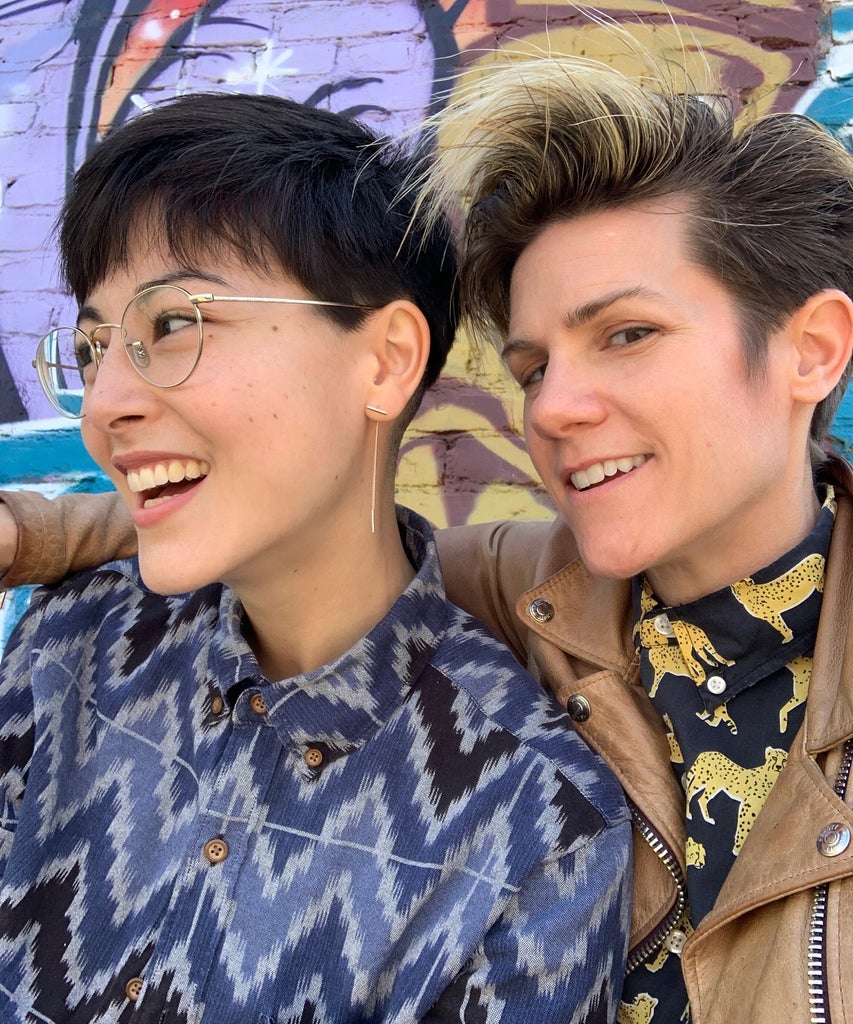
One of the first things I saw Katy do was fight for her life. This was after she’d seen me begin navigating a divorce, after we’d traveled together internationally for my job, and after I’d seen her slinging calls at hers. I loved that, as a book agent, she had an assistant she treated very kindly and wore a headset to take the myriad calls that came in each day. She looked like a boss. A good boss. One of those bosses that gets you something surprisingly personal for your birthday.
I reference her job because Katy is a complete person with interests, hobbies, a small town background, and an Ivy League education. And, she lives with a chronic illness that during an early-in-the-relationship visit to see me in Los Angeles — she lived in New York at the time — landed her in the hospital for ten days.
I say “the hospital” but the details are much more elaborate. After a few days of worsening fatigue, she took herself to the ER with shortness of breath and chest pains. I was out at the time — recording a podcast, I think — and met her there. She was released later that evening with a prescription for antibiotics. The next morning, she felt and looked much worse — shakier, now fully gasping for each breath. We took a Lyft to a second, closer-to-my-apartment ER run by a private insurance company. But they wouldn’t admit her. Or sign-off on discharging her. She was left in medical limbo, stuck in the ER.
After several hours on the phone with her insurance company, and advocacy by her doctors and workplace, she was transferred via ambulance and admitted to a third hospital, one I’d never heard of despite eight years living in LA. After three days of confusion and irregular, apathetic contact with doctors (one stormed out of the room yelling, “This is my Saturday!” after Katy asked a follow-up about whether she should continue taking a specific medication), a nurse pulled me aside and said, “We don’t have the capacity to treat her here. You need to sign her out Against Medical Advice, drive her down the street to a better equipped hospital and go through the ER there. That’s what I would do for my family.”
We went to the fourth ER in my 2005 Honda CR-V, not an ambulance. She still had an IV in her arm, a high fever and was wearing three sweatshirts to stay warm. We sat for nine hours in that fourth ER’s waiting room — Katy taking intermittent breathing treatments and oxygen from the triage nurse when she neared passing out — and we both cried happy tears when she was finally admitted, five days later and ten pounds lighter than when she’d started the process. By then, she’d developed an infection and collapsed her lungs. It took several more days of tests, procedures, guessing, and checking before a treatment of a super-high dose of steroids began to take effect, and months before she really got her lung capacity back.
This was last year. And her diagnosis: the common cold.
So when word first spread about COVID-19, it hit our household differently than perhaps it was received by other folks in our age group. We’re both in our 30s. I’m very healthy. Katy has an autoimmune disease that her doctors treat with immunosuppressant drugs and that contributed to this recent history of pneumonia. She’s a high-risk person in an otherwise low-risk group. But managing her health, as she often reminds me and I regularly remind myself, is not my job. I am a standup comic and did not go to medical school, despite the many scrolls I may currently be doing across social platforms.
In late 2019, Katy was headhunted for a job as an editor with a mandate to acquire queer books at her dream publisher, a job she could work remotely from Los Angeles. It seemed like the universe’s answer to the newish problem of our long-distance relationship. I say newish because at our relationship’s start, the distance is part of what made things work; I needed time to attend to the process of divorce and take space for myself without relying on a new partner as my primary support system. For her part, Katy had a strong community in New York but had been thinking a move somewhere calmer would benefit her health, and had been planning on Los Angeles being that place before we even met. With her job offer, her relocation to LA suddenly had a shape and timeline. She took it and we started to try a life together.
Most of the time, that life is light, airy, expansive. We share nerdy, glasses-wearing interests — like Disney-sing-alongs, Scrabble, reading — and Katy has absolutely no idea who any celebrity or standup comic or twitter personality is, which definitely helps me keep my choice of career in perspective. She is supportive and thoughtful, routinely doing things like ordering a giant HAPPY PUBLICATION DAY banner and decorating our apartment for a two-person, mid-quarantine launch party as a best possible stand in for the nationwide book tour I’d had planned for this week in a pre-quarantine world.
And also: Her health is a part of her life, and by proxy, my life, and our life together. When she got a fever two weeks ago and began to monitor it, checking in with her doctors as symptoms like a dry cough and chest pains emerged, health updates became part of our daily conversation. Yesterday, when her doctor suggested she go to Urgent Care for a chest x-ray after the chest pains began to include shortness of breath, I drove her, and waited outside in the hall as the security guard instructed, unable to join her in the waiting room as a contagion prevention measure. When a doctor came out to inform the family in that low-serious tone no one ever wants to hear, it was me who received the news that she would be quickly transferred via ambulance to a nearby ER to rule out a blood clot in her lung — an ailment I’d recommend not googling, as “sudden death” is listed as a primary symptom.
In fact, I even asked the doctor, “Wait… Is this deadly?” because her demeanor was so severe. “Yes,” she answered. “But it can be treated if caught in time.”
It was me who followed the ambulance, who was sent home because possible COVID-19 patients can’t have visitors, and who was told not to call the hospital but to FaceTime Katy for updates instead. But it wasn’t me who was transferred via ambulance, taken into the COVID-19 ward at that ER, who fought for a test as a high risk patient before being discharged with a presumed COVID-19 diagnosis because, according to her doctors, it was safer at home than at the hospital. That was Katy.
As I write this, I can hear her labored breathing in the next room. One of the hardest things about loving someone with chronic illness is not being in the real battle with them — not being able to lend energy, immunity, not being able to take any of the pain. I have to remember: That’s one of the hardest things about loving anyone, always. At least it is for me.
I’m built to think I should prioritize other people’s battles over my own. I don’t know if that’s latent Catholicism or the community oriented bent of queerness or a problem of boundaries that I am definitely working through in therapy. I do know I often feel empathy that is so strong, I can lose sight of myself.
I know I have to take stock in the arrogance of that kind of need to help. I know I can’t breathe through her lungs for her. I’d always prefer she take an ambulance if she needs to, instead of being driven between ERs in my jalopy. What I can do is my own work, which this week has been a lot of press about the very book she threw me a cute party for — my first, a memoir called Save Yourself, which really is the oddest title any book released right now, but a person writing this essay could have — and I can write this and I can take breaks and stay in touch with friends and get support for myself and still make sure she has everything she needs.
When I perform, Katy sits in the audience. When I’m sad, she gives me space to feel and work through it on my own. She doesn’t fix it because sadness isn’t a problem to be fixed. Similarly, keeping her safe and healthy isn’t in my control — or hers — no matter how vigilantly we both wash our hands. We can take precautions, but we can’t control outcomes.
Which is why it’s fantastic that Katy doesn’t need me to be in control. She needs someone to listen, someone to laugh with — or if laughing is hard, someone to bring in broth and receive the news from doctors and reason through what we’ve heard and ask, “How are you?” and say, “I hear you.” She has healthcare providers; I’m her partner.
Right now I’m scared for her, and following the instructions to not hug or sleep in the same room as her because of her presumed diagnosis is frustrating. I cannot imagine the pain being experienced by those whose cases are currently worse, or by those who aren’t in the same quarantined household as their loved ones fighting this, who are much further away. This is a fucking bonkers time, and if you know someone who loves someone fighting this, check on them.
And now — if you’ll excuse me — I’m going to check on Katy.
COVID-19 has been declared a global pandemic. Go to the CDC website for the latest information on symptoms, prevention, and other resources.
Like what you see? How about some more R29 goodness, right here?
Some Of You Never Learned About Inside Clothes



